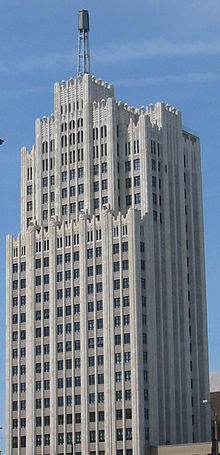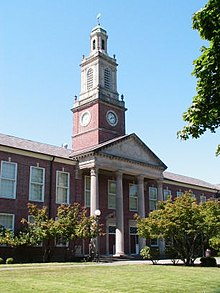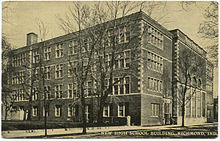| William B. Ittner | |
|---|---|
 Ittner, c. 1921 Ittner, c. 1921 | |
| Born | (1864-09-04)September 4, 1864 St. Louis, Missouri, U.S. |
| Died | 1936 St. Louis, Missouri, U.S. |
| Nationality | American |
| Occupation | Architect |

William Butts Ittner (September 4, 1864 – 1936) was an American architect in St. Louis, Missouri. He designed over 430 school buildings in Missouri and other areas, was president of the St. Louis Chapter of the American Institute of Architects from 1893 to 1895, was awarded an honorary degree by the University of Missouri in 1930, served as president of the Architectural League of America during 1903–04, and at the time of his death was president of the St. Louis Plaza Commission, a fellow and life member of the American Institute of Architects, and a thirty-third degree Mason. He was described as the most influential man in school architecture in the United States and has a star on the St. Louis Walk of Fame. He was appointed St. Louis School Board commissioner in 1897 and is said to have designed open buildings that featured "natural lighting, inviting exteriors, and classrooms tailored to specific needs." In 1936, Ittner died.
Background
His parents were Anthony F. and Mary Butts Ittner. His father worked at a lead plant and then as a bricklayer before founding Ittner Bros. with his brother Conrad in 1859. William Ittner's father (later a U.S. Congressman) helped establish the trade school from which his son graduated in 1884 "with the first class granted diplomas by Washington University's Manual Training School." He also graduated with a degree in architecture from Cornell University College of Architecture, Art, and Planning, traveled in Europe and married Lottie Crane Allen in St. Louis. He worked in the office of Eames & Young between 1889 and 1891, then practiced alone "before entering brief partnerships, first with William Foster and then with T. C. Link and Alfred Rosenheim."
He was elected to the new office of Commissioner of School Buildings for the School Board of St. Louis in 1897 and remained in the position until he resigned in 1910. He continued as "consulting architect" to the Board until October 1914. His first school design was Eliot School (1898–99) and his last was Bryan Mullanphy (1914–15).


He is credited with the design of over 430 schools nationwide and has over 35 buildings on the National Register of Historic Places. E-shaped schools were said to be his trademark.
Architectural innovations
Many of the architectural planning and designs seen in schools today were developed by Ittner. Some examples include:
- Integrated ventilation: Ittner designed chases to be placed behind lockers, which allowed air from inside the school to exit through chimneys.
- Natural lighting: Ittner integrated large windows, skylights, and lightwells in order to introduce light inside school buildings.
- Standardized plans: Ittner constructed plans that would effectively connect the specialized places of the school into one, cohesive unit. These plans included the H-Plan, I-Plan, and L-Plan.
- The Community School Concept: Ittner used site planning concepts to allow school resources to be available to residents in the surrounding areas.
Projects
Residences
- 6034 West Cabanne Place, St. Louis, Missouri (1891)
- 2137–2139 California Avenue, St. Louis, Missouri (1893)
- 3439 Longfellow, St. Louis, Missouri (1893)
- 3013 Hawthorne, St. Louis, Missouri (1894)
- 3435 Hawthorne, St. Louis, Missouri (1895)
Schools


- Board of Education Building, St. Louis, Missouri (1893) (NRHP)
- Arlington School, St. Louis, Missouri (1898) (NRHP)
- Jackson School, St. Louis, Missouri (1898) (NRHP)
- Rock Spring School, St. Louis, Missouri (1898) (NRHP)
- Simmons Colored School, St. Louis, Missouri (1898) (NRHP)
- Eugene Field School, St. Louis, Missouri (1900) (NRHP)
- Wyman School, St. Louis, Missouri (1900) (NRHP)
- Grant School, St. Louis, Missouri (1901) (NRHP)
- Ralph Waldo Emerson School, St. Louis, Missouri (1901) (NRHP)
- Horace Mann School, St. Louis, Missouri (1901) (NRHP)
- Eliot School, St. Louis, Missouri (1901) (NRHP)
- Harris Teachers College, St. Louis, Missouri (1906) (NRHP)
- Hempstead School, St. Louis, Missouri (1906) (NRHP)
- Gardenville School, St. Louis, Missouri (1907)
- Greenville High School, Greenville, Ohio
- Sumner High School, St. Louis, Missouri (1908)
- Ralph Waldo Emerson School, Gary, Indiana (1908) (NRHP)
- Carr School, St. Louis, Missouri (1908) (NRHP
- Soldan High School, St. Louis, Missouri (1909)
- Wichita High School, Wichita, Kansas (1910) (NRHP)
- Central High School, South Bend, Indiana (1911) (NRHP)
- Delaney School, St. Louis, Missouri (1911) (NRHP)
- Mark Twain School/Goodall School, Webster Groves, Missouri (1911 & 1927)
- Shelbyville High School, Shelbyville, Indiana (1911) (NRHP)
- Hume-Fogg High School, Nashville, Tennessee (1912) (NRHP)
- Grover Cleveland High School, St. Louis, Missouri (1913)
- Delmar-Harvard School, University City, Missouri (1913)
- Thomas C. Miller Public School, Fairmont, West Virginia (1914) (NRHP)
- McClain High School, Greenfield, Ohio (1915)
- W. H. Adamson High School, Dallas, Texas (1915)
- The Wilson School, St Louis, Missouri (1916)
- Forest Avenue High School, Dallas, Texas (1916) (NRHP)
- Francis L. Cardozo Senior High School, Washington, D.C. (1916) (NRHP)
- Marshall School, St. Louis, Missouri (1918) (NRHP)
- Frankfort Community High School, West Frankfort, Illinois (1920)
- Former Niagara Falls High School, Niagara Falls, New York (1921) (NRHP)
- Franklin School, St. Louis, Missouri (1923) (NRHP)
- Normandy High School, Normandy, Missouri (1923)
- Belleville High School-West, Belleville, Illinois (1924)
- Central High School, Columbus, Ohio (1924)
- Bel-Nor Elementary School, Bel-Nor, Missouri (1926)
- St. Petersburg High School, St. Petersburg, Florida (1926) (NRHP)
- Robert Alexander Long High School, Longview, Washington (1927) (NRHP)
- Dunbar School, Fairmont, West Virginia (1928) (NRHP)
- Fairmont Senior High School, Fairmont, West Virginia (1928) (NRHP)
- Maplewood-Richmond Heights High School, Maplewood, Missouri (1929)
- Nipher Middle School, Kirkwood, Missouri (1929)
- Ramsey High School, Birmingham, Alabama (1930)
- Lincoln School, Springfield, Missouri (1930)
- Keysor Elementary School, Kirkwood, Missouri (1930)
- Robinson Elementary School, Kirkwood, Missouri (1930)
- University City High School, University City, Missouri (1930) (NRHP)
- Theodore Roosevelt High School, Gary, Indiana (1930) (NRHP)
- Lew Wallace School, Gary, Indiana (1930)
- Bailey School, Springfield, Missouri (1931) (NRHP)
- Phelps School, Springfield, Missouri (1931)
- Hanley Junior High School, University City, Missouri (1936) (demolished 1985)
- Morton High School, Richmond, Indiana (1939)
- Park City Junior High School, Knoxville, Tennessee (NRHP)
- Greenfield Educational Complex, Greenfield, Ohio**
- Froebel School, Gary, Indiana (1912)(NRHP)
- Horace Mann School, Gary, Indiana (1926)
Other buildings
- Masonic Temple, Belleville, Illinois (1915)
- Missouri Athletic Club, St. Louis, Missouri (1916) (NRHP)
- Principia Page-Park YMCA Gymnasium, St. Louis, Missouri (1919) (NRHP) (significant expansion to 1910 structure designed by A.B. Groves)
- Scottish Rite Cathedral, St. Louis, Missouri (1921)
- Ainad Temple, East St. Louis, Illinois (1922)
- St. Louis Colored Orphans Home, St. Louis, Missouri (1922) (NRHP)
- Masonic Temple, Webster Groves, Missouri (1923)
- Shriners Hospital for Crippled Children, St. Louis, Missouri (1922) (NRHP)
- Masonic Temple, Maplewood, Missouri (1924) (demolished c. 1984)
- Missouri State Teachers Association Building, Columbia, Missouri (1927) (NRHP)
- Continental Life Building, St. Louis, Missouri (1929)
References
- ^ Carolyn Hewes Toft William B. Ittner, FAIA (1864–1936) Archived 2011-10-03 at the Wayback Machine Landmarks Association of St. Louis
- William B. Ittner at archINFORM
- ^ Educational architecture in Ohio Archived 2014-06-30 at the Wayback Machine: from one-room schools and Carnegie ... By Virginia Evans McCormick page 107
- St. Louis Walk of Fame. "St. Louis Walk of Fame Inductees". stlouiswalkoffame.org. Archived from the original on 31 October 2012. Retrieved 25 April 2013.
- ^ Archived 2010-03-24 at the Wayback Machine 09-04-1864 6661 Delmar inducted 10-04-2008 St Louis Walk of Fame
- "Landmarks Association of St. Louis :: Architects :: William B. Ittner, FAIA (1864-1936)". www.landmarks-stl.org. Archived from the original on 2020-09-19. Retrieved 2020-05-04.
- "History| Ittner Architects | Experts in Education". ittner. Archived from the original on 2020-08-07. Retrieved 2020-05-04.
- Collins, Cameron (2012-09-05). "The St. Louis Schools of William B. Ittner". NEXTSTL. Archived from the original on 2020-12-02. Retrieved 2020-11-03.
- "Nipher Middle School: Our History". Kirkwoodschools.org. Kirkwood School District. Archived from the original on April 23, 2019. Retrieved April 22, 2019.
- "Keysor Elementary School: Our History". Kirkwoodschools.org. Kirkwood School District. Archived from the original on April 19, 2019. Retrieved April 18, 2019.
- "Robinson Elementary School: Our History". Kirkwoodschools.org. Kirkwood School District. Archived from the original on April 19, 2019. Retrieved April 18, 2019.
- "Indiana State Historic Architectural and Archaeological Research Database (SHAARD)" (Searchable database). Department of Natural Resources, Division of Historic Preservation and Archaeology. Archived from the original on 2018-11-23. Retrieved 2019-03-07. Note: This includes Gregg Abell (December 2010). "National Register of Historic Places Inventory Nomination Form: Theodore Roosevelt High School" (PDF). Archived (PDF) from the original on 2019-03-08. Retrieved 2019-03-07. and Accompanying photographs.
- "Phelps School, Springfield, Mo". Archived from the original on 6 September 2015. Retrieved 4 February 2018.